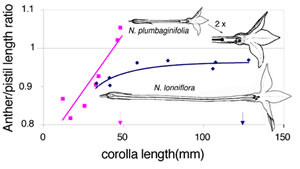Timothy Holtsford
Timothy Holtsford
PhD, 1989 University of California - Riverside
Floral evolution, species divergence, and mating systems in flowering plants
We are interested in the population genetic processes that influence floral evolution, species divergence and changes in the mating system in flowering plants. The impressive floral radiation of Nicotiana Section Alatae provides opportunities to study plant-pollinator interactions and the evolution of self-pollination.
Lately, we have worked on the pollinator-associations and their contribution to the species boundary between N. alata (pollinated by hawkmoths) and N. forgetiana (pollinated by hummingbirds, Ippolito et al., 2004), nectar variation and its relation to pollinator associations in all 8 spp. (Kaczorowski et al. 2005), heritability and correlation structure of floral and nectar traits (Kaczorowski et al., 2008) and crossability and pollen tube growth rates in crosses among all species (Lee et al., 2008).
Our current projects are focused on the evolution of self-pollination in N. longiflora and N. plumbaginifolia. N. plumbaginifolia is autogamous and self-pollinates before flower opening. Self-fertilization is a very effective gene flow barrier and has certainly contributed to the divergence of N. plumbaginifolia from N. longiflora. Nicotiana longiflora includes three morphologies and mating systems. Most of N. longiflora is protandrous and herkogamous yet self-compatible. Second, a mid-size morph, a putative hybrid, is found in the hybrid zone between N. plumbaginifolia and N. longiflora in NW Argentina. In the midsize morph stigma receptivity and anther dehiscence occur simultaneously, and with very little spatial separation, presenting a competitive arena for selfed vs. outcrossed pollen for ovule access. Third, self-incompatibility is segregating in at least one population found in NW Argentina.
Our current experimental approaches include genetic marker development for quantitative trait locus identification; quantitative and Mendelian genetics; pollen tube growth dynamics using light microscopy; and natural and synthetic population experiments in natural habitats, the glasshouse and the MU Genetics Farm.

